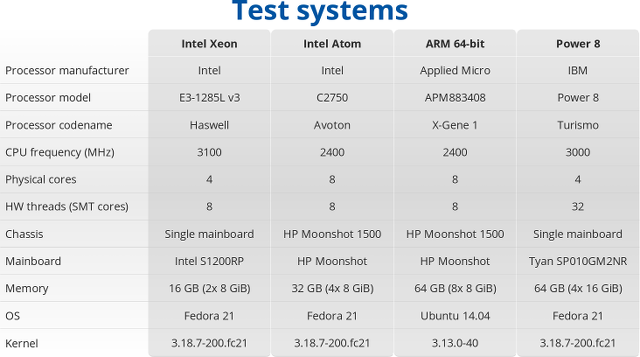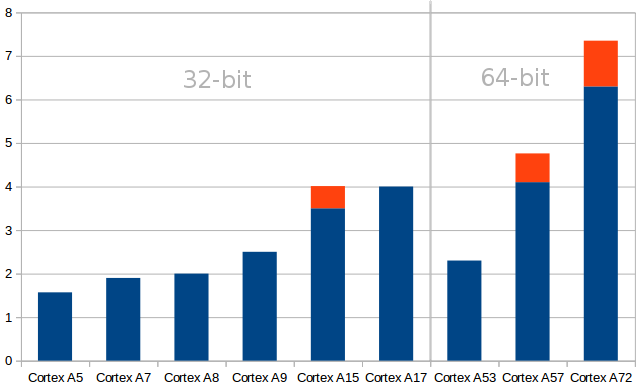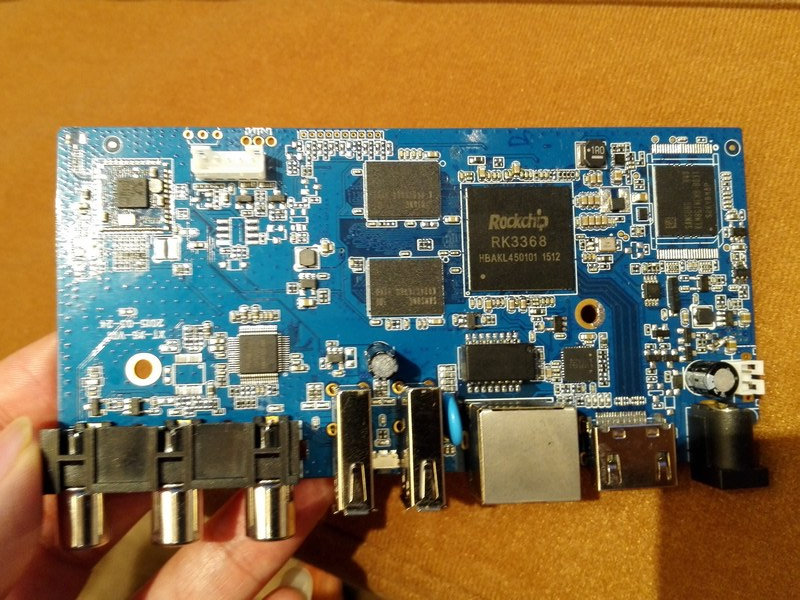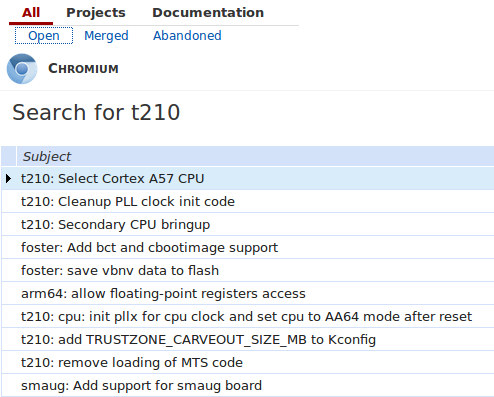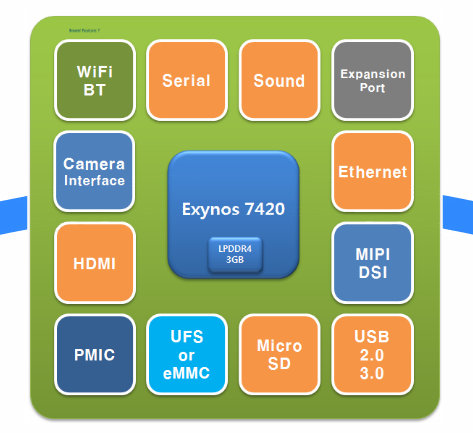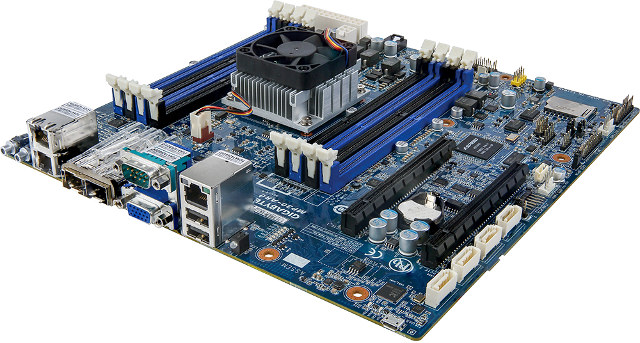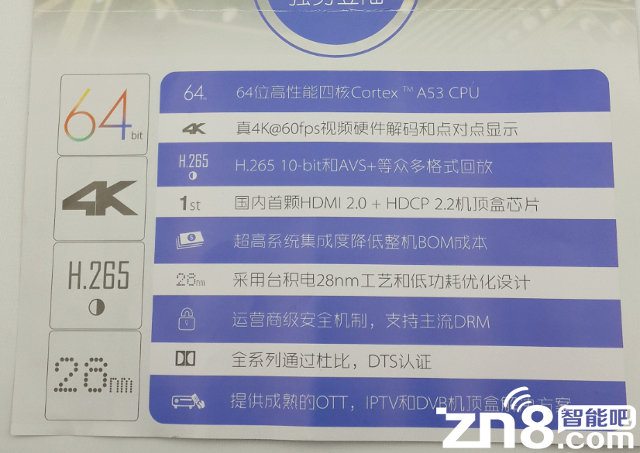Linus Torvalds “Ima Sheep” released Linux Kernel 4.0 on Sunday: So I decided to release 4.0 as per the normal schedule, because there really weren’t any known issues, and while I’ll be traveling during the end of the upcoming week due to a college visit, I’m hoping that won’t affect the merge window very much. We’ll see. Linux 4.0 was a pretty small release both in linux-next and in final size, although obviously “small” is all relative. It’s still over 10k non-merge commits. But we’ve definitely had bigger releases (and judging by linux-next v4.1 is going to be one of the bigger ones). Which is all good. It definitely matches the “v4.0 is supposed to be a_stable_ release”, and very much not about new experimental features etc. I’m personally so much happier with time-based releases than the bad old days when we had feature-based releases. That said, there’s a few […]
HPC Performance & Power Usage Comparison – Intel Xeon E3 vs Intel Atom C2720 vs Applied Micro X-Gene 1 vs IBM Power 8
Last year, the CERN published a paper comparing Applied Micro X-Gene (64-bit ARM) vs Intel Xeon (64-bit x86) Performance and Power Usage, and they’ve now added IBM Power 8 and Intel Atom Avoton C2750 processor to the mix in a new presentation entitled “A look beyond x86: OpenPOWER & AArch64“. So four systems based on Intel Xeon E3-1285L, Intel Atom C2750, Applied Micro X-Gene 1, and IBM Power 8 were compared, all running Fedora 21, except the HP Moonshot 1500 ARM plarform running Ubuntu 14.04 and an older kernel. All four systems use gcc 4.9.2, and Racktivity intelligent PDUs were used for power measurement. I’ll just share some of their results, you can read the presentation, or go through the benchmark results to find out more. HEP-SPEC06 is a new High Energy Physics (HEP) benchmark for measuring CPU performance developed by the HEPiX Benchmarking Working Group, and here it’s not […]
Relative Performance of ARM Cortex-A 32-bit and 64-bit Cores
Many people assume newer processors will be faster, or that 64-bit processor will provide a performance boost compared to 32-bit processors, but the reality can be quite different, and I’ve decided to have a look at ARM Cortex-A cores using ARMv7 (32-bit) and ARMv8 (64-bit) architecture, and see what kind of integer performance you can expect from each at a given frequency. To do so, I’ve simply use DMIPS/Mhz (Dhrystone MIPS/Megahertz) values listed on Wikipedia. Drystone benchmark has no floating-point operating, so it’s a pure integer benchmark. I’m only looking at ARM core here, and once integrated in an SoC, other parameters like memory bandwidth, amount of cache, GPU, etc.. will greatly affect the overall system performance. The figure above are per MHz, and it does not mean for example that a Cortex A5 processor will be slower than a Cortex A7 processor, as can be seen by the comparison […]
Rockchip RK3368 64-bit ARM Android Boxes Are Coming Soon
Yesterday, Rockchip had an event for their Atom x3-C3230RK SoCs (previously known as Sofia) developed in collaboration with Intel, and upcoming Android 5.1 tablets and smartphones based on the new platform, as well as progress with their first 64-bit ARM SoC (RK3368) that is now integrated into Android TV boxes, albeit still in development. Padnews wrote a summary of the event, but in this post I’ll focus on Rockchip RK3368 hardware. One of the first product will be X6 TV box. Padnews did not have a readable picture with the specs, but Eric of Geekbuying also went to the event, and kindly provided a clear picture with the specs (Mali-600MP is however not the GPU used in RK3368): SoC – Rockchip RK3368 octa core Cortex A53 processor with PowerVR G6110 GPU with support for OpenGL ES 1.x/2.0/3.x, OpenGL 3.2, DirectX 9.3, OpenCL 1.2 EP, and Renderscript System Memory – 1 […]
Tegra X1 Chromebooks Likely in the Works
When Nvidia announced Tegra X1 processor, the company’s main focus appeared to be the automotive market as it introduced Drive PX and CX board for this very market. Since then, Tegra X1 based SHIELD console was unveiled, and I’ve been informed some development activity related to Tegra X1 (Model: Tegra210 / T210) was taking place in Chromium and especially Coreboot source code. There appears to be two hardware platforms based on Tegra X1: smaug and foster which could end-up being Chromebooks or Chromeboxes likely with 4GB RAM. Thanks to David for the information. Jean-Luc Aufranc (CNXSoft)Jean-Luc started CNX Software in 2010 as a part-time endeavor, before quitting his job as a software engineering manager, and starting to write daily news, and reviews full time later in 2011. www.cnx-software.com
Howchip is Teasing ExSOM-7420SB Development Board Based on Samsung Exynos 7420 Processor
We’ve already seen a few Cortex A53 boards announced in the last few months with Nobel64, as well as Hikey & DragonBoard 410c 96Boards, but none of them are based on the more powerful Cortex A57 cores. Howchip is going to change that with the upcoming ExSOM-7420SB single board computer featuring Samsung Exynos 7420 processor used in Galaxy S6 smartphone. The company has released very few details about the board, except the block diagram above that shows Exynos 7420 with 3GB LPDDR4 PoP memory, and various interfaces such as USB 2.0/3.0, UFS/eMMC, Ethernet, HDMI, MIPI DSI, Camera, as well as Wi-Fi and Bluetooth connectivity. The board will support Android 5.0 Lollipop 64-bit. No word about Linux. That’s the video teaser, but you won’t learn much… More details should eventually be published on ExSOM-7420SB product page. Alternatively, Hardkernel will also probably launch an ODROID-XU4? board based on the latest Exynos 7 […]
Gigabyte MP30-AR0 is an ARM Server Motherboard Powered by Applied Micro X-Gene 1 SoC
So far, it’s been pretty hard to buy ARM server motherboards for individuals, as most, if not all, products were reserved to corporate entities, but with Gigabyte MP30-AR0 server motherboard featuring the first generation Applied Micro X-Gene 64-bit ARM processor this might be about to change. [Update: As mentioned in comments I was probably wrong here, since the motherboard is listed on the Gigabyte’s B2B website, and not its B2C website]. MP30-AR0 specifications: Processor – AppliedMicro X-Gene 1 processor with 8 ARMv8 cores up to 2.4GHz (TDP 45W) System Memory – 8 x DIMM slots, Single, dual rank UDIMM modules @ 1333/1600 NHz supported (up to 16GB) Storage – 4x SATA III 6Gb/s ports + 1x SD card slot Connectivity – 2x 10GbE SFP+ LAN ports (integrated), 2x GbE LAN ports (Marvell 88E1512), 1x 10/100/1000 management LAN Graphics – Video Integrated in Aspeed AST2400. 2D Video Graphic Adapter with PCIe […]
Amlogic is Working on S905 and S912 64-bit ARM Cortex A53 Processors
The relatively popular Amlogic S805 and S812 Cortex A9 processors are soon going to be joined by Amlogic S905 and S912 processors, both featuring ARM Cortex A53 64-bit cores, with the former destined to entry-level media players, and the latter for higher end devices including 4K60 / HDMI 2.0 support, as well as H.265 and AVS+ hardware video codecs. The company is now showcasing its new processors at China Content Broadcasting Network Exhibition (CCBN) 2015 in Beijing until March 28. Details are sparse, but we still know a few features for the new Amlogic 64-bit ARM processors: CPU – Quad Core ARM Cortex A53 CPU @ 2.0 GHz with 512KB unified cache. GPU – S905: 5 core Mali-450MP to 750MHz with OpenGL ES 11./2.0 and OpenVG 1.1 support, unnamed 2.5D GPU S912: TBD Video – 4K@60 Hz video decoding 10-bit HEVC and AVS+ codec support; H.264 up to 4K 30 […]



